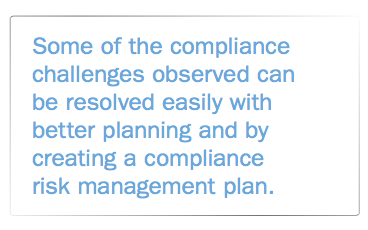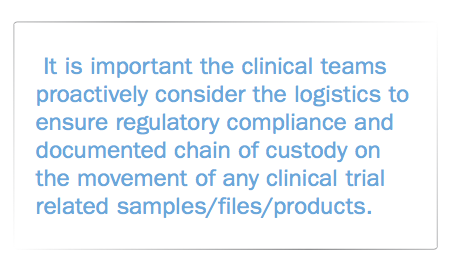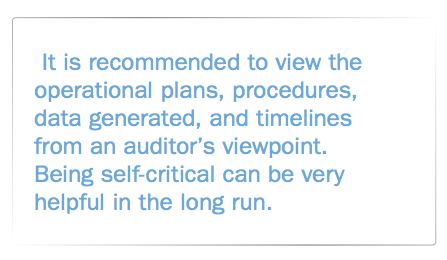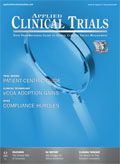An Auditor’s View of Compliance Challenges
Applied Clinical Trials
A look at the unique compliance and patient safety hurdles-and subsequent interventions-for resource-limited trial sites with no prior experience.

More and more clinical trials are being conducted in resource-limited regions of the world (about 15% to 20%).1 There are many reasons for this, including a higher concentration of willing and eligible participants; existence of rare and aggressive diseases in certain regions of the world; and socio-economic needs of certain regions to treat, cure and eradicate these diseases. As a result, pharmaceutical companies often collaborate with U.S. government agencies, global health organizations, private charities, contract research organizations (CROs), as well as local and regional governments to launch and execute clinical trials to prove the safety and efficacy of their products in these regions and markets.
All clinical trials present certain operational and compliance challenges. These challenges can have a devastating effect on the study endpoints and data if sites do not have experience in conducting clinical trials or are limited in resources like infrastructure, personnel, training capabilities, safety equipment, etc. This limitation in resources and experience can add an additional layer of complexity to the execution of the trial. In the case of multi-country clinical trials, the regulatory requirements of each collaborating country also have to be considered, which can often hinder the efficiency and speed of the trial.2 Most of the risks presented by these operational and compliance challenges can be addressed if planning is thorough, and issues are addressed swiftly.
The intent of this article is to bring attention to some of the most frequently encountered compliance and patient safety challenges and to suggest some early interventions. From my experience in auditing clinical research sites, operational challenges often get the most consideration at the resolution table, as operational teams must meet their deadlines to achieve the clinical trial milestones. The compliance challenges, however, often become secondary because of the lack of project milestones to measure compliance and inspection readiness. Follow-up on compliance challenges after the study start often leads to a continuously reactive cycle of addressing compliance issues toward or at the end of the clinical trial in

form of corrective actions, deviations, note to files, etc., which can lead to the loss of collected data.
Some of the compliance challenges observed can be resolved easily with better planning and by creating a compliance risk management plan. This plan will allow the clinical trial team to assess the potential compliance risks, determine the severity of those risks to the clinical trial data and the ultimate approval of the pharmaceutical product, and determine proactive actions that can mitigate and reduce those risks to tolerable levels.
Facilities
Facilities are often a challenge in resource-limited regions due to a general lack of an established research infrastructure.3 Limitations may include lack of available built space, electricity, basic equipment, and roads. The operational teams usually focus on preparing to get the enrollment started from an operational standpoint but often do not assess the compliance necessities from the regulatory as well as patient safety aspects. Some information to include in a compliance risk management plan related to facilities should be the following:
Electricity supply
It is not only important to have a generator and a back-up generator, it is also imperative to verify that the capacity of the generators will meet your needs. Project task lists should include time and resources for the documentation of the installation and testing of the generators with proper reviews and signatures. This documentation should be readily available for regulatory inspections and audits. The team should also confirm that there is a written generator maintenance plan and that there are records to show execution of that maintenance plan.
Buildings and roads
If the clinical site is located in a larger building (hospital, university, etc.), the clinical trial team often will need to assess the accessibility of the site for their subject population. This is usually not an issue in the U.S., however, in some resource-limited regions of the world, the operational team needs to carefully consider the need for disability access or emergency evacuation access for the study participants.
The clinical samples, subject files, and/or study product may also need to be transported periodically from one location to another. It is important the clinical teams proactively consider the logistics to ensure regulatory compliance and documented chain of custody on the movement of any clinical trial related samples/files/products. I have observed non-compliance in this area when teams “made do” with the available limited resources and transported study product without temperature monitoring or chain of custody, or transported subject files in personal vehicles without accountability.
This type of non-compliance can result in loss of data/samples/study product.
Basic equipment
Typically, equipment such as refrigerators, freezers, centrifuges, and coolers are either already present at the clinical research site and are in use for other trials or patient care or are brought in specifically for the purpose of a particular study. If such equipment is already in place, it is important to ensure the installation and calibration documentation is complete and available for review by auditors/inspectors. If this documentation is not available, the clinical team must plan proactively to get this equipment qualified and calibrated before using it for their study and ensure documentation is complete and available for review.
If new equipment is added, the clinical team must ensure the installation, qualification, and calibration of this equipment is executed and documented. In all

scenarios, monitoring and maintenance of such equipment should be documented and available for review at all times. Staff at inexperienced sites are unfamiliar with strict maintenance schedules and need to be instructed that these maintenance schedules are requirements not suggestions.
Equipment qualification/maintenance has been a challenge for sites that have typically provided routine patient care, but have not participated in a clinical trial. Regulations surrounding routine patient care can be different from country to country but those surrounding clinical trials must meet International Council of Harmonization-good clinical practice (ICH-GCP) standards, which in some cases may be either more stringent or more relaxed than the in-country regulations. The site staff often have difficulty understanding these differences initially, which leads to corrective actions and deviations.
Project teams need to not only plan for the qualification/maintenance of equipment, but also include staff training time and regular reinforcement of required schedules. Typically, in resource-limited areas there is a shortage of local expertise, often requiring a contractor to travel to the region to complete the task and documentation, which will require additional planning, time, and resources.
If a clinical site is processing and storing study samples even for short intervals, lack of documentation of proper functioning of equipment can jeopardize the integrity of collected samples, leading to loss of data. The same applies to the study product; if the site cannot provide evidence of proper and consistent storage of the product, the integrity of the drug can be questioned in the regulatory inspections. Planning can help avoid such high-risk issues.
Document storage and safety
Both FDA and the European Medicines Agency (EMA) have clinical trial record retention policies issued in their requirements;4,5 however, storage and safety of clinical trial records is frequently an afterthought in many sites, and is especially true at resource-limited clinical sites. In some cases, documents are stored in cabinets and in others they are kept in cardboard boxes. In both cases, documents are at risk from water and fire damage at all times.
Some sites have a designated person to file the documents and account for document removal but at most sites there is no designated document specialist resulting in a risk of losing and misfiling these documents, which again may lead to loss of trial data. Advanced planning is critical, especially because resource-limited sites are more dependent on paper documentation. A file management plan to address document flow and accountability, as well as potential risks such as a leaky roof should be defined before study start and revised periodically in the early stages of a trial and prior to changes in study logistical arrangements.
In addition, there is an issue of long-term storage of documentation, as clinical trial documentation needs to be available for inspections and regulatory filings for many years after the study activities are ceased at the clinical research site. Per experience, long-term document storage plans are usually created at the end of the trial and remain an open item in the audits until then.
Personnel training
The number of ICH-GCP trained personnel available in resource-limited regions is very limited and few have prior experience with clinical trials.3 Most of the time clinical site personnel are trained on ICH-GCP principles before the study start. These trainings are conducted either face-to-face or via webinars or online courses. Training materials focus on the ICH-GCP principles in terms of human subject protection (HSP) and requirements of GCP, but lack details regarding daily site operations or the potential impact of non-compliance with ICH-GCP requirements on the study. In addition, most training courses have case studies, but they are often not geared toward the disease indication that will be studied at that site. It is important that the ICH-GCP training for resource-limited clinical sites, especially sites that have not conducted research studies in recent years, be geared to the study/protocol at hand and draw out the stake and risks of non-compliance with ICH-GCP or data documentation.
Site personnel sometimes take short cuts in daily procedures because they do not understand the gravity of that procedure and the impact their action on the study data. Periodic reinforcement of this training with real-life examples can also go a long way for staff at inexperienced sites. In most cases, it is prudent to supplement the research-naïve site staff with experienced clinical staff from other regions.6 That approach can cause some staff blending challenges, but is usually extremely beneficial to have the additional depth of experience to support the inexperienced staff.
Another big challenge is the continuity of training as the protocol and procedures get amended and revised and new information becomes available throughout the study. This information is often not consistently communicated to all clinical site personnel because the site does not have an established training system. Even if the information is distributed, there is a lack of documentation of this training, which makes audits and inspections very difficult. There needs to be a designated training role at the site and a system to distribute and document training on the updates to the clinical trial documentation to maintain compliance as site staff and monitors rotate in-country over the course of the study.
Good documentation practices
Non-compliance to good documentation practices (GDP) is one of the most frequent findings in audits in resource-limited or inexperienced clinical research sites. “Key attributes for good documentation were first described by US-FDA in the form of ALCOA -attributable, legible, contemporaneous, original and accurate. These are also adapted by World Health Organization (WHO).”7 GDP training must be treated as its own module, instead of a small sub-set of the overall GCP training. This is because GDP has a high impact on clinical data in resource-limited sites as most of the data are recorded on paper. Some of the common GDP issues include changes in clinical notes without any initials and/or dates, inconsistent use of initials, multiple records of same data etc. These poor documentation practices make it very difficult to reconcile the clinical data in audits and inspections and can lead to loss of trial data. A real-time 100% peer review of all critical data points can significantly reduce loss of data in such cases.
Regulatory file and trial master file maintenance
“A TMF is the collection of documentation that allows the conduct of the clinical trial, the integrity of the 57 trial data, and the compliance of the trial with GCP to be evaluated. The requirement for a TMF is set 58 down in Directive 2001/20/ECi Article 15(5) and the TMF forms the basis for inspection (Directive 59 2005/28/ECii Article 16)”.8
Maintenance of the regulatory file and the TMF in inspection-ready state throughout the trial has been observed as one of the biggest challenge for resource-limited clinical sites. These trials involve many stakeholders-pharmaceutical companies; one or more government branches from the U.S.; local government agencies; and several different CROs-resulting in a large amount of electronic communication among the different parties involved. This communication is often not centralized, but instead resides in different places at different times, and in almost every trial, gets lost as equipment and devices used for this communication fail. Establishing a central communication forum/site that automatically feeds into the TMF can be helpful in these type of trials.
It is critical to have an experienced regulatory affairs specialist4 at each resource-limited clinical site who is responsible for maintaining the regulatory file at the site and submitting all documentation and communication to the TMF. In resource-limited regions that do not have experience in conducting clinical trials,

this position may have to be filled by personnel from other regions. In such cases, it is important that there is a long-term plan to train the local site personnel in this task and then eventually transition it to local site personnel with some oversight to ensure compliance. The best results are achieved if this position is created and filled before the trial begins. This position is often created and filled in the middle or toward the end of the trial, which is somewhat successful but some of the losses incurred in the earlier parts of the trial remain irreversible and thus lead to loss of trial data.
Conclusion
Clinical trials are long, expensive, and exhausting no matter where they are conducted, but they become especially challenging when resource-limited clinical sites with no prior clinical trial experience are involved. A little preparation and forward thinking can go a long way in reducing data loss and executing a successful study. It is highly recommended to view the operational plans, procedures, data generated, and timelines from an auditor’s viewpoint. Being self-critical can be very helpful in the long run.
Seema Garg, MS, MBA, CQA, CSSGB is a Quality Assurance Manager for Technical Resources International, Inc.
References
1. ClinicalTrials.gov; https://clinicaltrials.gov/ct2/search/map
2. Ndebele P., Blanchard-Horan C., Shahkolahi A., Danne I. Regulatory challenges associated with conducting multi-country clinical trials in resource-limited settings. J Acquir Immune Defic Syndr. 2014; 65(0 1): S29-S31. https://www.ncbi.nlm.nih.gov/pmc/articles/PMC3900239/
3. Runyon M.S., Sawe H.R., Levine A.C., Pousson A., House D.R., Agarwal P., Osei-Ampofo M., Weiner S.G., Douglass K. Clinical and Translational Research in Global Health and Emergency Care: A Research Agenda. Academic Emergency Medicine. 20(12). http://onlinelibrary.wiley.com/doi/10.1111/acem.12268/pdf
4. 21 CFR Part 312.57 Recordkeeping and record retention. http://www.accessdata.fda.gov/scripts/cdrh/cfdocs/cfcfr/CFRSearch.cfm?fr=312.57
5. Records management. European Medicines Agency, 2014. http://www.ema.europa.eu/docs/en_GB/document_library/Other/2010/04/WC500089596.pdf
6. Mbuagbaw L., Thabane L., Ongolo-Zogo P., Lang T. The challenges and opportunities of conducting a clinical trial in a low resource setting: The case of the Cameroon mobile phone SMS (CAMPS) trial, an investigator initiated trial. BioMed Central Ltd. Trials. 2011; June 9, 2011. https://trialsjournal.biomedcentral.com/articles/10.1186/1745-6215-12-145
7. Bargaje, Chitra. “Good Documentation Practice in Clinical Research.” Perspectives in Clinical Research 2.2 (2011): 59–63. PMC. Web. 5 Oct. 2016. https://www.ncbi.nlm.nih.gov/pmc/articles/PMC3121265/
8. Reflection paper on GCP compliance in relation to trial master files (paper and/or electronic) for management, audit and inspection of clinical trials. European Medicines Agency, 2015. http://www.ema.europa.eu/docs/en_GB/document_library/Scientific_guideline/2013/02/WC500138893.pdf

Improving Relationships and Diversifying the Site Selection Process
April 17th 2025In this episode of the Applied Clinical Trials Podcast, Liz Beatty, co-founder and chief strategy officer, Inato, discusses a number of topics around site engagement including community-based sites, the role of technology in improving site/sponsor relationships, how increased operational costs are impacting the industry, and more.
Behind the Buzz: Why Clinical Research Leaders Flock to SCOPE Summit
February 7th 2025In this episode, we meet with Micah Lieberman, Executive Conference Director for SCOPE Summit (Summit for Clinical Ops Executives) at Cambridge Innovation Institute. We will dive deep into the critical role of collaboration within the clinical research ecosystem. How do we bring together diverse stakeholders—sponsors, CROs, clinical trial tech innovators, suppliers, patients, sites, advocacy organizations, investors, and non-profits—to share best practices in trial design, program planning, innovation, and clinical operations? We’ll explore why it’s vital for thought leaders to step beyond their own organizations and learn from others, exchanging ideas that drive advancements in clinical research. Additionally, we’ll discuss the pivotal role of scientific conferences like SCOPE Summit in fostering these essential connections and collaborations, helping shape the future of clinical trials. Join us as we uncover how collective wisdom and cross-industry partnerships are transforming the landscape of clinical research.
FDA-Approved Gene Therapy Beqvez Shows Sustained Efficacy, Safety in Long-Term Hemophilia B Trial
April 17th 2025Beqvez (fidanacogene elaparvovec), an FDA-approved one-time gene therapy for hemophilia B, demonstrated sustained factor IX expression, low bleeding rates, and a favorable safety profile over long-term follow-up.